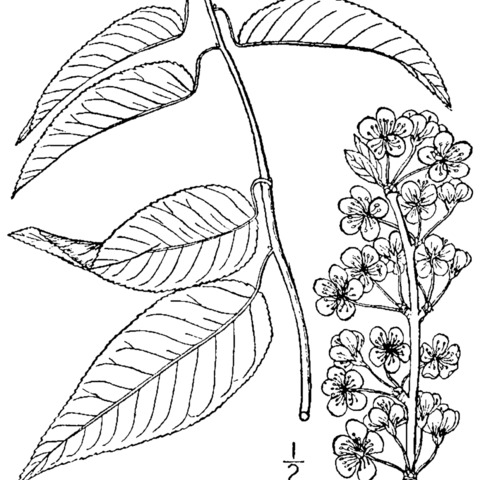Trees, rarely suckering, 40–100 dm, moderately thorny. Twigs with axillary end buds, glabrous. Leaves deciduous; petiole 6–20 mm, hairy on adaxial surface, usually glandular distally, glands 1–5; blade narrowly elliptic, lanceolate, oblanceolate, or oblong-obovate, (5–)7–11(–13) × (2–)3–5.5 cm, base obtuse to rounded, margins singly to doubly crenate-serrate, teeth blunt, glandular, ?glands inconspicuous, blackish?, apex long-acuminate, abaxial surface ± hairy along midribs and veins, adaxial glabrous or with hairs along midribs. Inflorescences 2–4-flowered, umbellate fascicles. Pedicels 8–20 mm, glabrous. Flowers blooming before or at leaf emergence; hypanthium campanulate, 2–3 mm, glabrous externally; sepals erect to reflexed, ovate, 1.5–3 mm, margins glandular-toothed, abaxial surface glabrous or sparsely hairy, adaxial densely hairy at bases; petals white, obovate, 4–9 mm; ovaries glabrous. Drupes red to yellowish with white dots, ?not or only slightly glaucous?, globose, 20–30(–40) mm, glabrous; mesocarps fleshy; stones ovoid-ellipsoid, ± flattened. 2n = 16.
More
Tree to 10 m; lvs oblong-lanceolate to oblong, 8–13 cm, long-acuminate, obtuse to rounded at base, sparsely hairy beneath or eventually subglabrous, finely serrate with triangular ascending teeth bearing a terminal gland; pedicels glabrous, 8–15 mm; sep glandular on the margin, pubescent above, at least at base, glabrous below; pet 5–7 mm; fr red, varying to yellow, 2–3 cm; 2n=16. Moist woods and thickets; chiefly in Mo. and Ill., but also irregularly to s. O., sw. Va., Tenn., n. Ark., ne. Okla., and e. Kans. Apr., May, the fls opening when the lvs are half-grown.
A small tree. It has a short trunk. It grows 6-9 m high and spreads 4.5 m wide. It loses its leaves during the year. The bark is dark brown and peeling. The leaves are 7-11 cm long by 2-3 cm wide. The leaves are light green. They have fine hairs and teeth along the edge. The flowers are white and in groups of 2-5. The fruit are red or yellow. They are edible.
Bottomlands, thickets and woodland edges, in rich moist soils. Roadside thickets, flood plains, open woodlands; at elevations from 50-500 metres.
More
Temperate. It grows in moist soils along streams. It suits hardiness zones 6-9.


